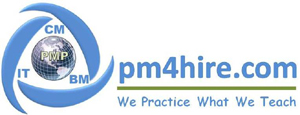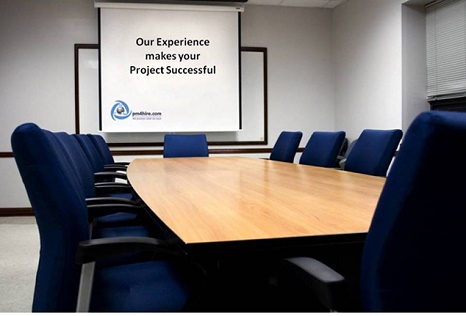

Project Management Consulting Services
Pm4hire.com is a boutique project management services and training provider – working closely to the PMP™ / PMBoK™ standard of excellence, while applying custom tools and techniques that make project management noticeably more effective. Project management is our passion: what we do not like about it we treat as an opportunity for improvement. Instead of a focus on mechanics that can be automated – we focus on facilitation, streamlining, and communications to keep a project on track. The following 4 areas are major success factors that helped Pm4hire.com to successfully deliver client centric projects.
Link to Liftoff Page
Client Centric Project Management (CCPM)
Our paradigm is to represent the client: we are their eyes and ears on the project. Our focus is to integrate the efforts of contributors so projects deliver to (or beyond) client expectations, and to avoid surprises of cost escalation or scope reductions. We educate or counsel the client on best options to protect their investment. We are never technology focused: we merely enable the business and/or production objectives for which a project is chartered.
CCPM applies to Information Technology (applications and infrastructure), construction, or business improvement initiatives. We minimize conflict, ensuring that every change is rationally explained and justified – but it is not always discretionary. Soil conditions may require deeper footings that will support only so many floors, so there are firm boundaries other than time and/or budget. CCPM implies a commitment to furnish clients with clear information on why certain decisions are required, and what options are available.
We never hide behind technological jibber-jabber: we ensure the client is informed and able to control the project to completion. We respect the charter: a definition of the responsibilities and the level to which control is delegated. We apply clear thresholds that define when work stops or how long it may continue while the client formulates a decision. We itemize the cost of “go / no-go” decisions at different tranches where a new state of completion is achieved.
CCPM methodology is differentiated by a results-focus within the work breakdown, as opposed to an activity focus. We want to know the cost of every component within every result – activity is the effort used to produce what we then reflect as a contributing cost (labor, materials, and other expenses) in a specific context. Clients know what each component costs and how or when work was performed. Our custom tools make it easy to track and report progress.
Pm4hire Custom Tools
Mechanics are reflected in tools that are the essence of project management. It is not about using excellent scheduling and tracking tools – it is about not mistaking schedules for “the plan” and creating a smokescreen that hides what is really important to achieve project objectives. A schedule is a roadmap to keep many things happening in a project organized in an process that delivers results, but this is neither predictive nor central to what is going on in that project.
Many useful, and generally accepted, tools exist in the market but, as cautioned in PMBoK™, you may not want a “one size fits all” approach: you want flexibility to adapt to what best suits your project(s). Tracking and reporting are essential to stakeholder management – companies and projects come in all sizes, so adapt that tracking and reporting to stakeholders’ needs rather than to “educate” stakeholders on how to read and interpret generic project management reports.
I offer different approaches for project scheduling, tracking and reporting by means of Excel™ workbooks with VBA automation. Almost everyone is able to master Excel™ to obtain custom information, so it is an ideal platform for custom stakeholder needs. Other, more expensive, tools have merit: if money is no constraint, use a project management tool with a high-end report writer, but for flexibility on a tight budget Excel™ is a viable selection.
Dynamic Project Management Methodology
Exceptions and change management are the norm for projects – it makes no sense to wait for all your ducks to be lined up: often the final details will not emerge until a project is underway. In many cases needs are not discovered until a project executes work activity that lets these details surface. Projects are initiated under uncertainty while project managers detail risks in order to mitigate impact on the project: that does not mean eliminating risks and holding to a baseline schedule.
A project that delivers the original scope on time and within budget may be a complete failure if the results are no longer relevant to current needs. We understand that if part of the project scope is “discovery and analysis” we must focus on adapting and accommodating by maintaining a controlled change management in the project. Clients must play an active role in the oversight of change requests: it is not a project decision to alter scope, it is a project recommendation with options and costs spelled out and for the client to approve, or not.
Pm4hire tools incorporate change management and risk management as key components within the scheduling and tracking process. This helps us manage the impact of change or to trigger a risk event that implements contingency workaround solutions. Assumptions are managed – many projects are kicked-off under a great deal of uncertainty (that is one of the reasons why a project approach is selected). We don’t want to lose control over the project because so many things keep changing at once.
A cynical approach (of Defense Industry and Government Sponsors) is to hide behind a concept of “Complex Project Management”: a supposedly more appropriate explanation for why fighter planes destroy more budgets than military targets. Perplexed project management seems a more appropriate designation for smoke and mirror planning: when initial cost estimates are unrealistic, designed to goad a client into signing a contract. Formal project management is more than adequate to reflect dynamic work effort and manage change by calling it what it is, so the client remains in control
Financial Planning & Budget Management
Financial plans and budget controls are big responsibilities for project management to succeed: effective tools emphasize that (something lacking in major project management software tools). Our tools feature integrated detailed financial budgeting and tracking, as well as contingency funding for exceptions and risk mitigation effort. While it makes a project seem more expensive, many “low cost” projects run late and over budget, and are then considered failures.
Our practice is based on detailed planning and budgeting: we make assumptions as required but this is documented with “optimistic” and “pessimistic” estimates to reflect different options and assumptions. We provide our best (or most likely) estimate, a least-cost estimate, and our high-risk estimate, using appropriate financial analysis models and detailed scheduling models with itemized budgets. Detailed budgets and cash flow forecasts concern the client who works within annualized funding constraints more than schedules and due dates.
The timing of go-ahead decisions has a major impact on financial plans and budget forecasts. Our automated models are key tools to facilitate on-going revisions to match conditions as they evolve. If nothing changes in a project except the start date that can impact budgets driven by fiscal years even if the grand total remains the same: the funding needs change for each fiscal year and that may, or may not fit a larger financial plan. We argue that projects must be flexible, but that does not alter the way the business is managed.
Pm4hire.com tools integrate schedule and budget forecast to better show how we expect cash flow to behave, when cash inflows are required to pay for goods and services, and the work in progress. Sometimes companies differentiate contracted work from internal work; as well costs can sometimes be capitalized, while capital costs may be expensed under certain materiality rules. Our processes recognize these differences: you may have to present the information in very specific formats, but at least you can audit the totals to make sure the budget is supported.
Our Goal as Consultants
With the best of intentions the project manager cannot foresee everything. As consultants we end up parachuting into a hornets’ nest from time to time, as details emerge that give us pause for concern about what else might emerge. Our goal is to provide as clear a picture of reality as possible as opposed to sugar-coating that reality in order to get a project approved. Sponsors and stakeholders are not ignorant about these realities – they will have more confidence in our ability to manage and mitigate the impact of such realities and they will be more inclined to approve a project when the risks are clearly identified and accounted for.
 |
|